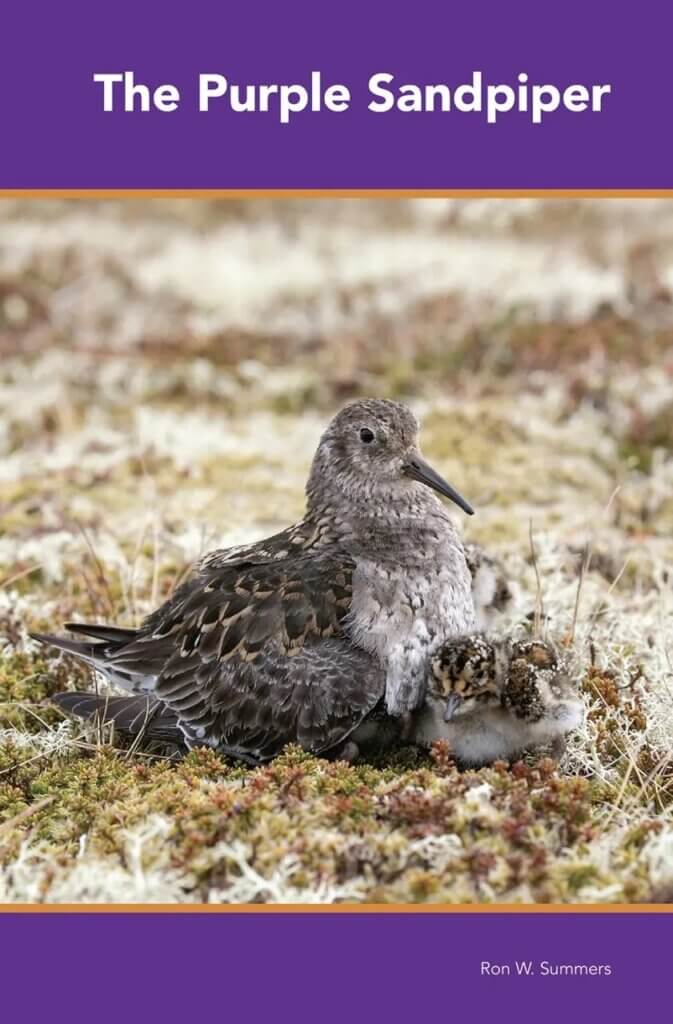
This is a wonderful book and it will undoubtedly be one of my top-10 books of the year for 2023. It is a self-published account of studies of this species, many of them led or enabled by the book’s author. And he did all this alongside his actual work being a research scientist in various bodies on various continents.
I should be up-front about the fact that this book takes me back to some happy memories of the bird and the author but any reader should be impressed by the tale of research over the decades and the progress made. It is a monograph, but we also learn an awful lot about other wading birds, ecology, evolution and how the trained mind can bit by bit unlock the mysteries of nature.
I can remember the first Purple Sandpiper (purp) I saw. It was at Sand Point in Somerset, on a Bristol Grammar School birdwatching trip in 1970 or 1971 when I was 12 or 13. I was struggling to spot the bird about which everyone else was enthusing until John Rossetti (a fellow pupil – though massively older than me) kindly pointed it out – I had been looking for the bird about 200 feet away whereas it was actually about 20 feet away. A great view of a dumpy, greyish/brown (purplish in good light) wader, perched on a rock and facing left.
Some 7-8 years later I was a member of an 8-man Cambridge University expedition to the Hardangervidda plateau in southern Norway to study Purple Sandpipers and other waders (such as Dotterel, Great Snipe, Dunlin) and we were doing that because someone called Ron Summers had said it would be a useful thing to do.
Years later I was part of the process of appointing Ron to a job in the RSPB Research Department (now Conservation Science) where he was a stalwart and made particularly useful contributions to pinewood ecology and species such as Capercaillie, Crested Tit and a bunch of crossbills.
There are 24 species of calidrine (of the genus Calidris and close relatives) waders in the world – they all nest in the Arctic (in at least part of their world range) and they all have superficially similar ecologies. The Purple Sandpiper has one of the smallest world populations, one of the smallest world ranges, one of the smallest movements between its breeding and non-breeding locations and is unusual in being seen on rocky shores, close to the waves in the non-breeding season. It’s not that purple and it’s not that often seen on sand – the Purple Sandpiper.
The 15 chapters cover every aspect of the bird’s life as best as they are known and describes the history of this long-term and continuing study. I agree with Jeremy Greenwood who, in a rightly very enthusiastic foreword, praises Chapter 2, the one about the evolution of the study, as being fascinating.
The species is much more interesting than you might think, the writing is clear, the tables and graphs are packed with succinct information and the photographs are numerous and cover the bird, the habitats and some of the people involved over the years. As a book it’s very well-produced and clearly written – a tour de force!
The cover? Yep, that’s an adult Purple Sandpiper and a very cute chick. You can’t fault it for relevance and it is attractive. I’d give it 8/10.
The Purple Sandpiper by Ron W. Summers is published by Ron Summers (I bought my copy from NHBS – click here).

Signed copies of my most recent book book, Reflections, are available from me.
Contact me at mark@markavery.info
Softback – £20 (incl UK P&P)
Hardback £26 (incl UK P&P)
[registration_form]
I agree with you Mark, this is really an excellent monograph